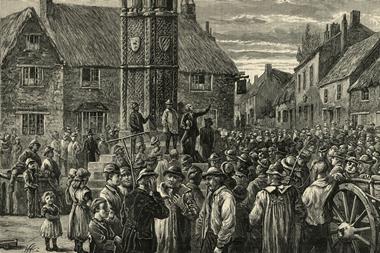Man and the machine: Philip Ball welcomes the age of automated chemical crystallography
‘The fact is that, partly thanks to the machine, we have now an insight into a larger world and a more comprehensive intellectual synthesis than that which was originally outlined in our mechanical ideology.’ The social theorist Lewis Mumford wrote these words in his analysis of industrialisation, Technics and civilization (1934). At one level the remark could be interpreted as saying that we have learnt a lot about the world through the agency of machines, but Mumford had a somewhat different implication in mind: we have learnt that the ‘machine ideology’, our instinct to replace human labour with machines, can be seen to make sense only when we coordinate the use of machines with ‘a humane scheme of living’. Replacing people with machines, he said, is beneficial so long as we eliminate the ‘servile work or slavery’ that Karl Marx flagged in his Communist manifesto (1848) as one of the chief evils of capitalism.
It would be wonderful to know what x-ray crystallographer Desmond Bernal would have made of the automation of crystallography, not least because he was a passionate Marxist (he called Marxism ‘the enemy of all dogmatism’). A student of William Bragg, Bernal was not just a pioneer of the x-ray crystallography of biomolecules but a towering figure in 20th-century science. He believed that the study of crystal structures through x-ray diffraction promised to unite all the sciences: it was a technique based in physics, dependent on chemical intuition, and offering an unparalleled window into the molecular secrets of biology.
Indeed, it’s amusing to see that Bernal had more faith in crystallography as a tool for molecular biology than did Francis Crick, who worried that the phase problem (the inability to decode the phases of reflected x-rays, essential for reconstructing a full three-dimensional picture of molecular structure) would derail its utility for complex molecules.
And to Bernal, crystallography was a fine art. ‘Among the most beautiful x-ray photographs of any substance ever taken’ was how he described the diffraction patterns of DNA obtained by Rosalind Franklin, which gave Crick and James Watson the vital information for deducing their structure of DNA. Could this technique - which elicited such imaginative flair from the likes of Bernal, Crick and Watson, William Astbury and Linus Pauling - really be anything like the ‘servile work’ that Mumford deemed fit for machines?
Automating crystallography
Well, times change. It was thanks to the efforts not only of these men but of some of the greatest female scientists of their age, including Kathleen Yardley Lonsdale, Dorothy Hodgkin and of course Franklin herself, that the fundamental motifs of biochemical structure - the double helices of nucleic acids, the coils and sheets of proteins - became known. X-ray diffraction remains central not only to molecular structural biology but to the study of small synthetic molecules, minerals and metal alloys. And yet it is now a routine, even a mundane technique. The romance of understanding the architecture of the molecules of life has given way to laborious decryption of how the familiar secondary motifs are arrayed in the countless enzymes and fibrous proteins that populate our cells.
Indeed, the very terminology of ‘high-throughput’ methods now being developed to solve all the structures of the human proteome signifies a task that must be done with as quickly and efficiently as possible. It is true that actually making crystals for the sample chamber is still a black art, but high-intensity x-ray sources (and thus short data collection times), robotic micromanipulation techniques and structure-refinement software have indeed rendered crystallography fit for machine labour.
Alexandra Slawin and colleagues at the University of St Andrews in Scotland, UK, have now developed a device that makes it just that.1 Their automated system, called Standard (St Andrews Automated Robotic Diffractometer), will usher a whole batch of mounted crystal samples in and out of the goniometer (which measures the angles between crystal faces), collect the diffraction data, solve the structure and inform the user once it is done. It has been commercialised in collaboration with Rigaku, and, given the simplicity of the sample mounting procedure, is pretty much idiot-proof. The art of the crystallographer - specifically, the ‘flexible thinking’ that the St Andrews team says is still needed to solve some tricky structures - is cunningly incorporated into the structure-refinement algorithms. The researchers admit that the machine might, like a new postgraduate student, occasionally need to seek guidance from its supervisors on particularly thorny problems.
If this is the future of crystallography, probably few will lament it: especially for biological macromolecules, the technique now depends more on graft than inspiration. But Mumford is always worth heeding: he said in essence that machines are all very well so long as they have productive problems to solve. One good new idea about the function of proteins is still worth a hundred hypothesis-free crystal structures.
References
1 A L Fuller et al, J. Am. Chem. Soc., 2010, 132, 5799 (DOI: 10.1021/ja100247y)

















No comments yet